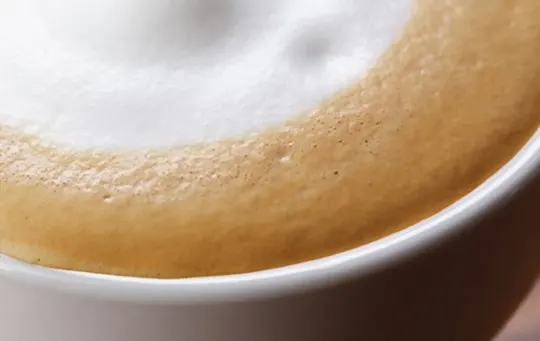In the epic caffeine saga, two contenders vie for the crown: wet and dry cappuccinos. We love our coffee rituals – the buzz, the aroma, that first sip feeling like a hug to our brain.
A wet cappuccino, with its silky mix, feels like wearing your favorite cozy sweater. The dry version? It’s like that crunchy autumn leaf – all crisp and bold.
Our mornings often start with this dilemma. We’ve tried both, swapping tales of coffee triumphs and mishaps.
Now, we’re spilling the beans on which brew rules the roost.

What is a Wet Cappuccino?

A cappuccino that contains a higher proportion of milk than foam is known as a “Wet Cappuccino.
” The preparation of this cappuccino involves adding more steamed milk to the shot of espresso.
Although it’s a variation on the traditional form, it has its own appeal.
When ordering a Wet Cappuccino, the barista usually adds an equal volume of milk and foam to the espresso shot.
However, it is still considered a cappuccino despite its lower foam content.
As a result, the drink is warmer and creamier than other variations of the drink.
What is a Dry Cappuccino?

A Dry Cappuccino is a variation of the traditional cappuccino that has less steamed milk and more foam.
This means that the drink is drier in texture, and the foam provides a lighter feel.
The dryness of the drink makes it an ideal option for individuals who prefer less milk and a stronger coffee taste.
The amount of foam in a Dry Cappuccino creates a layering effect when prepared correctly.
When preparing a Dry Cappuccino, baristas will typically start with pulling espresso shots into the cup and then adding minimal steamed milk followed by a thick layer of microfoam on top.
The key here is to not use too much milk but enough to bring out the flavor in the espresso without overpowering it.
The foam helps to keep the espresso hot while providing additional texture and flavor.
Understanding the Difference Between Wet and Dry Cappuccino

Cappuccino is a popular coffee beverage that can be enjoyed in different styles.
One such style is Wet vs Dry Cappuccino, where the milk foam’s texture becomes an essential factor.
In Wet Cappuccino, the milk is steamed to a velvety consistency and poured over the espresso shot.
The resulting drink has a smooth taste with the right balance of espresso and milk.
On the contrary, in Dry Cappuccino, the milk foam is finely textured and used in tandem with espresso shots.
The difference between these two varieties lies in their unique textures.
While Wet Cappuccino enjoys a comparatively smoother finish due to higher steamed milk content, dry cappuccino has more air trapped within it due to micro-foam, creating velvety bubbles on top.
Moreover, A barista can make each of them stronger or weaker by adjusting the amount of brewed espresso.
It’s worth noting that both wet and dry options have their exclusive virtues, making it dependent entirely on the consumer’s preference for coffee texture to decide which one is better.
Therefore, knowing about the differences between these essential nuances transforms your ordering experience at any café or restaurant you visit—a true way to relish that perfect cup of coffee without compromise.
Milk Ratio
The ratio of milk to espresso is significant in determining the quality and taste of a cappuccino.
Generally, a traditional cappuccino comprises equal parts of espresso, steamed milk, and frothed milk.
However, some baristas use different proportions based on personal preference or customer demand.
For most coffee enthusiasts, 1/3 espresso and 2/3 milk (equal parts frothed and steamed) make the ideal cappuccino.
This proportion allows the espresso’s rich and robust flavor to blend perfectly with the frothy and creamy milk texture.
It’s important to note that factors such as temperature, consistency, and quality of ingredients also play a significant role in creating a perfect cappuccino.
By finding the perfect balance between these elements, baristas can create an exceptional coffee experience for their customers without sacrificing depth of flavor or velvety texture.
Texture and Consistency
Cappuccinos are a popular coffee beverage that comes in two variations: wet and dry.
The texture and consistency of a cappuccino play a crucial role in determining the type of taste and experience one might have.
- Wet Cappuccino Texture: Wet cappuccino has a smooth, creamy texture due to its milk froth. This frothing technique creates a creamy foam layer on top of the shot of espresso, resulting in a sweeter taste.
- Dry Cappuccino Texture: Dry cappuccinos, on the other hand, have less steamed milk, which creates more foam. Therefore, dry cappuccinos have a distinct bubbly texture with little sweetness.
- Intense Flavor: A dry cappuccino is pure espresso mixed with foam that gives an intense flavor compared to a wet cappuccino that dilutes the espresso by adding extra steamed milk.
It’s important to note that both types have their own unique attributes.
For instance, if you prefer sweeter drinks, then you should opt for a wet cappuccino.
If not, then the dry version may be more preferable for your taste buds.
Overall, whether you choose wet or dry cappuccino depends on your preferences for taste and texture.
It’s best to experiment with both until you find your preferred style.
Flavor Profile
Cappuccino is a popular espresso-based beverage consisting of three equal parts – espresso, steamed milk, and foam.
The coffee flavor and texture are defined by the amount of foam and steamed milk used in preparation.
Wet cappuccinos contain more milk than foam, whereas dry cappuccinos have more foam and less milk.
Wet cappuccinos tend to be creamier with a smooth texture since the extra milk added balances the bitterness of the espresso.
On the other hand, dry cappuccinos have a strong coffee flavor as it contains a higher quantity of foam.
The amount of sugar or syrup used in each type affects the sweetness levels.
One unique characteristic of wet cappuccinos is that they can be paired with various syrups like vanilla or caramel to enhance sweetness levels.
While dry cappuccinos are better suited with dark chocolate or bitter flavors.
In general, your preference for either wet or dry variants depends on your taste preferences.
If you prefer a creamy drink with less bitterness, go for wet cappuccino; if you desire a stronger coffee flavor, try out the dry option.
Factors to Consider in Choosing Between Wet and Dry Cappuccino

When choosing between wet and dry cappuccino, several factors should be considered.
The texture preference of the individual should be taken into account, as well as the type of milk used and the skill level of the barista.
Wet cappuccino has more steamed milk and less foam than a dry one, resulting in a creamier texture.
In contrast, dry cappuccino has less steamed milk and more aerated milk foam, resulting in a lighter texture.
The choice ultimately depends on personal taste and preferences.
Personal Preference
For coffee aficionados, choosing between a dry and wet cappuccino is often a matter of personal preference.
The dry option features more foam and less milk, while the wet option features more milk and less foam.
Both variations have their unique flavor profiles, but the choice ultimately comes down to individual taste and texture preferences.
While some people may prefer the lightness and airy texture of a dry cappuccino with its rich espresso base, others may enjoy the creamier texture of a wet cappuccino that offers a strong balance between steamed milk and espresso.
It is also important to note that different baristas may interpret each variation differently, resulting in slight variations in taste or texture.
Ultimately, when deciding between a dry and wet cappuccino, it is important to consider personal taste preferences as well as the specific interpretation of the beverage by your favorite barista.
By taking into account these factors, coffee lovers can ensure they are always enjoying their preferred style of cappuccino.
Caffeine Content
The caffeine content in wet and dry cappuccinos varies based on the ratio of espresso, milk, and foam used in the respective drinks.
A traditional wet cappuccino contains more milk and less foam than a dry one, resulting in a lower caffeine concentration.
On the other hand, a typical dry cappuccino has more foam and less milk, which provides a stronger caffeine hit.
Additionally, factors such as bean type, brewing time, and water temperature also affect the caffeine levels in both versions.
In terms of taste preference and caffeine requirements, it is essential to choose wisely between wet or dry cappuccinos based on individual needs.
While some may prefer a milder taste with lower caffeine levels through wet cappuccinos for health reasons or late-night consumption, others may enjoy a stronger espresso flavor with higher caffeine concentration from the dryer version for an instant energy boost.
Overall, it is crucial to consider the caffeine content while ordering your favorite cappuccino to ensure your coffee drinking requirements are satisfied accordingly.
Dietary Restrictions
For individuals with dietary limitations, selecting a cappuccino that fits their diet can be challenging.
A variety of dietary restrictions include halal, kosher, gluten-free, vegan, or lactose-intolerant.
Customers can opt for non-dairy milk options like almond, soy, coconut or oat milk as a replacement for cow’s milk in their cappuccino.
This helps cater to individual needs and ensures that everyone can enjoy their favorite coffee drink without sacrifice.
It’s essential to communicate your dietary limitations to the barista while placing an order to ensure no accidental inclusion of ingredients or items on the drink you cannot consume.
Many cafes offer alternative options for gluten-free bread and vegan snacks too.
Individuals with dietary limitations must consider all aspects before enjoying a cappuccino.
It is beneficial to read the cafe’s menu beforehand to search ingredient lists included in drinks and baked goods.
By doing so, you’ll avoid any allergy-related issues.
Cafes have upped their game by providing a diverse range of options to cater to different dietary restrictions.
From plant-based foods to dairy-free alternatives in drinks – this trend is here to stay and brings joy back into the lives of those who have long struggled with finding safe meal choices outside home/office environments.
How to Make a Wet Cappuccino?
Making a cappuccino requires attention to detail, with the difference between a wet and dry cappuccino playing a significant role in the end result.
Achieving a perfect wet cappuccino takes understanding the right mix of steamed milk and espresso.
To make a Wet Cappuccino, follow these five steps:
- Start with freshly ground coffee beans and pull a double shot of espresso into your cup.
- Steam your milk to create a velvety microfoam- aim for less foam than you would with dry cappuccino.
- Pour your milk slowly over the espresso to create the wet texture desired. Be sure not to incorporate too much air into your pitcher as this will result in a dry texture.
- Add any desired toppings such as cinnamon or cocoa powder on top of your milk foam.
- Finally, serve while hot and enjoy.
It is important to note that achieving the perfect wet cappuccino takes practice and an eye for detail, so be prepared to experiment with different milk textures to find what works best for you.
Understanding how to make a wet cappuccino can greatly enhance your coffee brewing game.
This method allows for a creamier, smoother taste compared to that of the dry counterpart.
Remember, when striving for perfection, small changes can make all the difference.
How to Make a Dry Cappuccino?
Dry cappuccino is a popular espresso-based drink that has a frothy, dry milk foam topping.
Creating a dry cappuccino involves following certain steps while preparing the coffee and milk.
Here is a simple 6-step guide to making a delicious dry cappuccino.
- Start by brewing a shot of espresso using your preferred method.
- While the espresso is brewing, steam the milk in a separate jug until it reaches around 60-65 degrees Celsius.
- Tap the milk jug on a hard surface and swirl the milk around to create microfoam.
- Slowly pour the frothy milk onto your brewed espresso.
- Hold back some of the milk foam with a spoon to create less liquid and more foam, thus giving you that dry cappuccino texture.
- Serve immediately with an optional sprinkle of cocoa powder or cinnamon.
If you want an extra rich taste, use full-fat dairy or non-dairy milk while steaming.
Additionally, using fresh high-quality beans will enhance the flavor of your coffee.
Enjoy your homemade dry cappuccino.
Conclusion
After analyzing the differences between wet and dry cappuccinos, it can be concluded that both options have their unique taste.
Dry cappuccino has a more foamy texture and a stronger coffee flavor, whereas wet cappuccino feels creamier with less foam and milkier taste.
One’s preference varies based on individual tastes.
Additionally, one should consider the type of coffee beans, quality of milk, and the barista’s skill level while deciding on their choice.
Those who prefer a bolder taste may opt for a dry cappuccino whereas individuals who prefer a smoother milky flavor may choose a wet cappuccino.

Wet vs Dry Cappuccino: Which is a Better Option?
Ingredients
- Wet Cappucino
- Dry Cappuccino
Instructions
- Choose between a wet cappuccino and a dry cappuccino based on your preference for milk foam.
- For a wet cappuccino, ask your barista to prepare it with a higher ratio of steamed milk to foam.
- For a dry cappuccino, request a lower ratio of steamed milk to foam, resulting in a thicker layer of foam on top.
- Enjoy the rich flavors and creamy texture of your chosen cappuccino style.
- Explore both wet and dry cappuccinos to discover your preferred balance of milk and foam.

Andrew Gray is a seasoned food writer and blogger with a wealth of experience in the restaurant and catering industries. With a passion for all things delicious, Andrew has honed his culinary expertise through his work as a personal chef and caterer.
His love for food led him to venture into food writing, where he has contributed to various online publications, sharing his knowledge and insights on the culinary world. As the proud owner of AmericasRestaurant.com, Andrew covers a wide range of topics, including recipes, restaurant reviews, product recommendations, and culinary tips.
Through his website, he aims to inspire and educate fellow food enthusiasts, offering a comprehensive resource for all things food-related.

Leave a comment